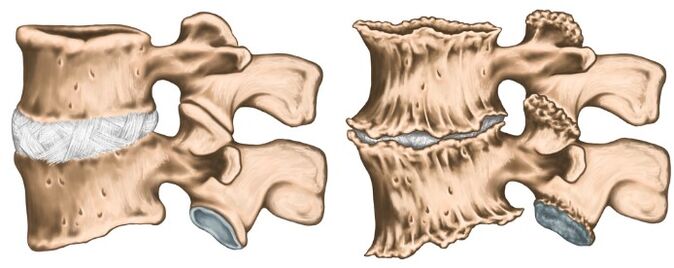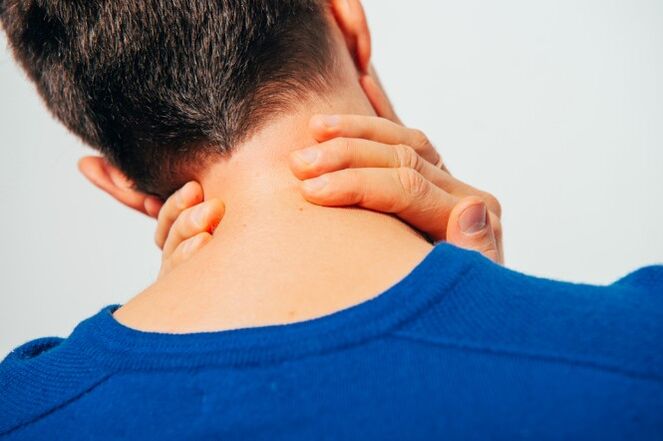With osteochondrosis of spinal columns, many are not familiar with popular gear from TV screen, but from their own sad experiences.Statistics are hard: up to 80% of the population suffers from the disease, which is also much younger.If the previous complaints to the problem in the spine are among the older generations, now the osteochondrosis of the children is no longer surprised anyone.And inactive lifestyle mistakes and the "benefits of civilization" mentioned.

Cervical spinal osteochondrosis is a polyetiological progressive disease indicated by the deterioration of the intervertebral disc and the dysfunction of the spinal ligament.Everyone knows about symptoms directly, but this knowledge is fragment;We will try to organize it, as well as talk about the principles of diagnosis and treatment of cervical spinal osteochondrosis.
The cause of osteochondrosis
Medical science cannot respond firmly, which is why osteochondrosis occurs.It is well known that an inactive lifestyle that modern people tend to negatively affect the development of the disease.It is interesting that both hypodynamia and many athletes lead to disc proxies.Descent factors play a major role.The following reasons are distinguished:
- the history of the descendants of the burden;
- obesity;
- hypodynamia;
- metabolic disorders in the body;
- traumatic damage to the spinal column;
- Long static loads and work related to weight lifting (working on computers, weight lifting, miners, movers, etc.);
- scoliosis;
- Environmental conditions that do not work;
- flat feet and pregnancy;
- Hypothermia and stress, which often cause the severity of the disease.
There are some neurological syndrome:
- shoulder -periathritis;
- root;
- Heart;
- Vail artery syndrome.
Shoulder -periathritis.It is characterized by pain in the neck, shoulders, shoulder joints.The leading neurogenic contract of the shoulder joint is formed, which is protected, as it protects the axillary nerve from stretching.With this position, the muscles surrounding the joints are in tension.The severity of the pain syndrome depends on the severity of the osteochondrosis: at the slightest limit of amplitude of movement in the joints to the coordinated "frozen" shoulder, when any movement causes severe pain.The pain increases as the shoulder is removed and pronounced, as this movement increases the tension of the axillary nerve.

Royshift Syndrome (Radiculite Cervix).Usually occurs with cervical osteochondrosis.At the same time, the spinal cord is squeezed due to the "submerged" of the intervertebral disc, as well as due to the growth of osteophytes or disk enlargement in the side direction.The pain syndrome is specific: intense burning, tearing, pressing pain, which is also increasing as the patient moves his head.Antalgia pose is also noted in the neck muscles, they are very tense and painful, the amount of movement is limited.There is pain in the back of the head, neck, front chest, shoulder, between shoulder blades.Disruption of sensitivity by type "half a jacket with short sleeves" is a feature.
Cardial Syndrome.The name of the syndrome is responsible for itself: the clinical picture is very similar to the angina pectoris.In this case, there is no organic damage to the heart, at the height of the pain syndrome, the infringement of the coronary blood flow by the ECG is not detected, and such patients are well received.Typical features with angina pectoris: Pain occurs after taking nitrate, and in the case of osteochondrosis has not changed and disrupts for a long time.Unlike angina pectoris, the localization of pain is mainly in the liver on the left.With the root irritation of the C8 - T1 segment, rhythmic disorders in the form of tachycardia and extrasystole are possible.This is not due to damage to the heart that runs the heart, but by violating the conservation of sympathetic heart muscle (extracardiac damage).In the diagnosis of differentiation of angina pectoris and cardiac syndrome, the main is the fact that, in addition to the carddial complaint, the patient recorded an increase in pain in the shoulder and neck joints associated with lifting or hard motion.
Vail artery syndrome.The vertebral artery occurs in the channel formed by holes in the horizontal process of the vertebra.The artery is paired, it is responsible for the blood supply to the brain.Therefore, any narrowing of this channel greatly has a negative effect on brain tissue nutrition.The vertebral artery syndrome develops directly with the compression of the artery itself and with the sympathetic nerve plexus irritation, located around it.The pain in this pathology burns or pulses in the occipital region by spreading to whiskey, tutorial arc, crow.It arises on both sides.Patients usually associate deterioration with conditions after sleep in non -physiological pose, travel in transport, walk.With obvious symptoms, hearing loss, dizziness, ear noise, nausea, vomiting, loss of consciousness, and increased blood pressure are possible.Such symptoms are not specific and very similar to complaints in cerebral stroke.This pathology is characterized by the Syndrome Capel Syndrome: Fatigue that occurs when you cancel the back head (severe brain ischemia).He was described by the visitor to the Sistine chapel in the Vatican as they examined the wall painting in his gate.It may also fall without losing consciousness with a sharp head turn.
As with the diagnosis in medicine, the diagnosis of osteochondrosis is established based on patient complaints, disease anamnesis, clinical examination and additional research methods.X -Ray the cervical spine in direct and lateral projections is performed, if necessary in a special position (with open mouth).At the same time, experts are interested in the height of the intervertebral disc, the presence of osteophytes.Modern research methods, IAMR and CT research are used, which allows for accurate diagnosis.In addition to the additional research methods listed, the consulting consultation (cardiologist, eye specialist, neurosurgeon) may be needed, and neurologist examination is important.Neurologists are involved in the treatment of osteochondrosis, so after examining the patient, he will prescribe the minimum examination required at his discretion.

Osteochondrosis treatment
Osteochondrosis is a polyetiological disease, for one course of therapy not cured.You cannot drink "magic pills" and everything will pass, it is necessary to change your lifestyle basically, as triggers are hypodynamia.The most significant results are easier to achieve in the early stages of the disease, when the complaint is minimal and there is no compression and spinal artery syndrome.At the acute stage of the disease, when the following group of drugs is prescribed the so -called pain: the pain syndrome is pronounced:
- Therapeutic paravertebral blockade (to relieve pain and removal of muscle cramps);
- NSAIDs;
- ointment containing NSAID and reflex actions;
- muscle relaxants;
- B Vitamin V.
When the inflammation process decreases and the release of the pain syndrome, they switch to physiological therapy treatment.Often, the following techniques are used:
- laser therapy;
- electrophoresis;
- acupuncture;
- Exercise therapy;
- therapeutic massage;
- Manual therapy.
It is important to understand that osteochondrosis runs with a period of severity and forgiveness, so it is very important to affect the cause, and not treat the investigation.































